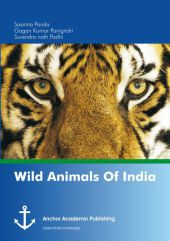 Neuerscheinungen 2016Stand: 2020-02-01 |
Schnellsuche
ISBN/Stichwort/Autor
|
Herderstraße 10
10625 Berlin
Tel.: 030 315 714 16
Fax 030 315 714 14
info@buchspektrum.de |

Surendranath Padhi, Sasmita Panda, Gagan Kumar Panigrahi
(Beteiligte)
Wild Animals Of India
2016. 68 S. 14 Abb. 220 mm
Verlag/Jahr: ANCHOR ACADEMIC PUBLISHING 2016
ISBN: 3-9606701-4-1 (3960670141)
Neue ISBN: 978-3-9606701-4-8 (9783960670148)
Preis und Lieferzeit: Bitte klicken
This book on "Wild Animals Of India" has been written with a motive to provide information at a glance to the readers interested in wildlife. The animals chosen for the study were of greater interest because they have been declared endangered, critically endangered, vulnerable or priority species in the IUCN Red data book and most of the species are included as course material at undergraduate and post graduate levels in Indian Universities. Hence, this is an endeavour to create awareness among the student community on Wild Life Biology.
Efforts have been made to acquaint the readers with geographical distribution, habit, habitat, reproductive behavior and conservation measures of the animals.
´Text sample:
CHAPTER 3, CHEETAH:
CLASSIFICATION:
Kingdom: Animalia, Phylum: Chordata, Class: Mammalia, Order: Carnivora.
Family: Felidae, Genus: Acinonyx, Species: jubatus, Sub-species: venaticus.
GENERAL CHARACTERS:
The Asiatic cheetah (Acinonyx jubatus venaticus), also known as the Iranian cheetah, is a critically endangered cheetah subspecies surviving today only in Iran. It used to occur in India as well, where it is locally extinct. The Asiatic cheetah lives mainly in Iran´s vast central desert in fragmented pieces of remaining suitable habitat. Although once common, the cheetah was driven to extinction in other parts of Southwest Asia from Arabia to India including Afghanistan. As of 2013, only 20 cheetahs were identified in Iran but some areas remained to be surveyed. The total population is estimated to be 40 to 70 individuals, with road accidents accounting for 40% of deaths. Efforts to stop the construction of a road through the core of the Bafq Protected Area were unsuccessful. In order to raise international awareness for the conservation of the Asiatic cheetah, an illustration was used on the jerseys of the Iran national football teamate the 2014 FIFA World Cup. Currently in 2015, it is estimated that approximately 50 cheetahs are living in the wild of Iran, however their numbers are rising. The Asiatic cheetah separated from ist African relative between 32,000 and 67,000 years ago. Along with theEurasian lynx and the Persian leopard, it is one of three remaining species of large cats in Iran today. During the British colonial times in India it was called hunting leopard, a name derived from the ones that were kept in captivity in large numbers by the Indian royalty to use in hunting wild antelopes. In Dutch, the cheetah is still called jachtluipaard. The Hindi word cita is derived from the Sanskrit word chitraka meaning "speckled". Asiatic cheetahs are slimmer, lighter and slightly shorter than their African brethren. The head and body of an adult Asiatic cheetah measure from 112-135 cm (44-53 in) with a tail length between 66 and 84 cm (26 and 33 in). It weighs from 34 to 54 kg (75 to 119 lb). Males are slightly larger than the females.The cheetah is the fastest land animal in the world. It was previously thought that the body temperature of a cheetah increases during a hunt due to high metabolic activity. In a short period of time during a chase, a cheetah may produce 60 times more heat than at rest, with much of the heat, produced from glycolysis, stored to possibly raise the body temperature. The claim was supported by data from experiments in which two cheetahs ran on a treadmill for minutes on end but contradicted by studies in natural settings, which indicate that body temperature stays relatively the same during a hunt. A 2013 study suggested stress hyperthermia and a slight increase in body temperature after a hunt. The cheetah´s nervousness after a hunt may induce stress hyperthermia, which involves high sympathetic nervous activity and raises the body temperature. After a hunt, the risk of another predator taking their kill is great and the cheetah is on high alert and stressed. The increased sympathetic activity prepares the cheetah´s body to run when another predator approaches. In the 2013 study, even the cheetah that did not chase the prey experienced an increase in body temperature once the prey was caught, showing increased sympathetic activity.
HABIT AND HABITAT:
The Asiatic cheetah preys on small antelopes. In Iran, ist diet consists mainly of Jebeer gazelle (also called Chinkara), Goitered gazelle, wild sheep, wild goat, and Cape hare. The main threat to the species is loss of their primary prey species due to poaching and grazing competition with domestic livestock. A study published in 2012 indicated that hares and rodents, while forming part of the cheetah´s diet, are not a significant source


